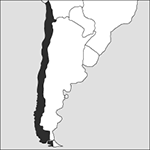
Source: MAPS IN MINUTES™ © RH Publications (1997)
Capital:
Santiago
Area:
756,102 sq km (291,933 sq miles)
Population:
17,216,945 (2012 est)
Currency:
1 peso = 100 centavos
Religions:
Roman Catholic 70.0%; Evangelical 15.1%
Ethnic Groups:
White and Mestizo 95.4%; Mapuche 4.0%
Languages:
Spanish (official); also Amerindian languages (mostly Araucanian)
International Organizations:
UN; OAS; Non-Aligned Movement; WTO; OECD
A long and narrow country on the west coast of South America, occupying some 4600 km (2860 miles) between Peru in the north and Cape Horn.
Physical
On average Chile is only 160 km (100 miles) in width from the Pacific to the high Andes, along which run the boundaries with Bolivia and Argentina. In the north is the arid Atacama Desert, while in the centre the climate is mild and conducive to most forms of agriculture. Tierra del Fuego, in the extreme south is cold, very wet, and relatively barren, suitable only for sheep grazing. Inland, along the whole length of the country, stretch mountains.
Economy
Chile’s economy is based largely on the exploitation of substantial mineral reserves, and agriculture. Copper, of which Chile is the world’s largest producer, is the major export and provides about 20% of government revenue; fruit, fishmeal, timber products, and wine are also important. Besides copper mining, industries include the production of other metals, food processing, and wood products. In 2010 Chile became the first South American country to join the OECD.
History
At the time of the first Spanish contact in 1536 the dominant Indian group, the Araucanians, were theoretically subject to the Inca empire, but in practice they retained considerable independence within the Inca realm. Though they resisted Spanish encroachments, the Araucanians were gradually pushed south of the Bío Bío River where they were more or less kept under control. Spanish colonization began with the foundation of Santiago in 1541. The colony grew moderately but did not prosper for the next two centuries as it was overshadowed by wealthier Peru. Politically Chile became part of the Spanish viceroyalty of Peru. Chilean independence from Spain was proclaimed in 1810 by O’Higgins; it was achieved after the South American liberator José de San Martín crossed the Andes with an army of 3200 men and defeated Spanish troops at the battles of Chacabuco (1817), and Maipo (1818). The discovery of rich copper deposits in the northern Atacama desert had a dramatic impact on economic life, with a railway system developing from 1851. Following war with Bolivia and Peru (1879–83), rich natural nitrate deposits were annexed in the north, leading to a 50-year economic boom. By the 1920s synthetic nitrates were replacing saltpetre and dependence on copper exports placed Chile at the mercy of the world market. Political experiments after World War II failed to cope with a series of burgeoning social problems and prompted the election in 1970 of the Marxist democrat Salvador Allende, the first avowed Marxist in world history to be elected President by popular vote. As the head of the Unidad Popular (a coalition of communists and socialists), Allende was faced with a majority opposition in Congress, and the hostility of the USA. He was increasingly frustrated in his attempts to implement his radical programme of nationalization and agrarian reform. Inflation, capital flight, and a balance-of-payments deficit contributed to an economic crisis in 1973. In September the army commander-in-chief Pinochet led the military coup which cost Allende and 15,000 Chileans their lives, and prompted one-tenth of the population to emigrate. The military regime which replaced Chile’s democracy brutally suppressed all labour unions and opposition groups, and pursued a free-market economy. Although inflation was dramatically reduced, so was demand, output, and employment. The economy continued on a downward spiral in the 1980s with the world’s highest per-capita level of external debt. In 1988 Pinochet accepted a plebiscite decision for the ‘re-establishment’ of ‘workable democracy’, and stepped down. In 1989 Patricio Aylwin (1918–2016) was elected President and civilian rule was restored. Aylwin was succeeded in 1994 by Edúardo Frei Ruiz-Tagle. Richard Lagos was elected President in 2000, and in 2006 Michelle Bachelet became Chile’s first woman President. Although her government’s social reforms were popular, the constitution prevented her contesting the 2009 election; this was won by the conservative Sebastián Piñera after a run-off in early 2010. Bachelet returned to power in 2014.
- supernova
- Supernova 1987A
- supernova remnant
- supernumerary chromosome
- super-Nyquist sampling
- superorganism
- Super Output Areas
- superoxide dismutase
- superoxides
- superparamagnetic limit
- superphosphate
- superplasticity
- superposition
- superposition principle
- Super Proton Synchrotron
- superqubit
- superradiance
- superradiant
- super-regenerative reception
- super-resolution microscopy
- super-rotation
- supersampling
- supersaturated design
- supersaturated solution
- supersaturation